26 Common Types of Sparrows in South Dakota (With Pictures)
Last Updated on
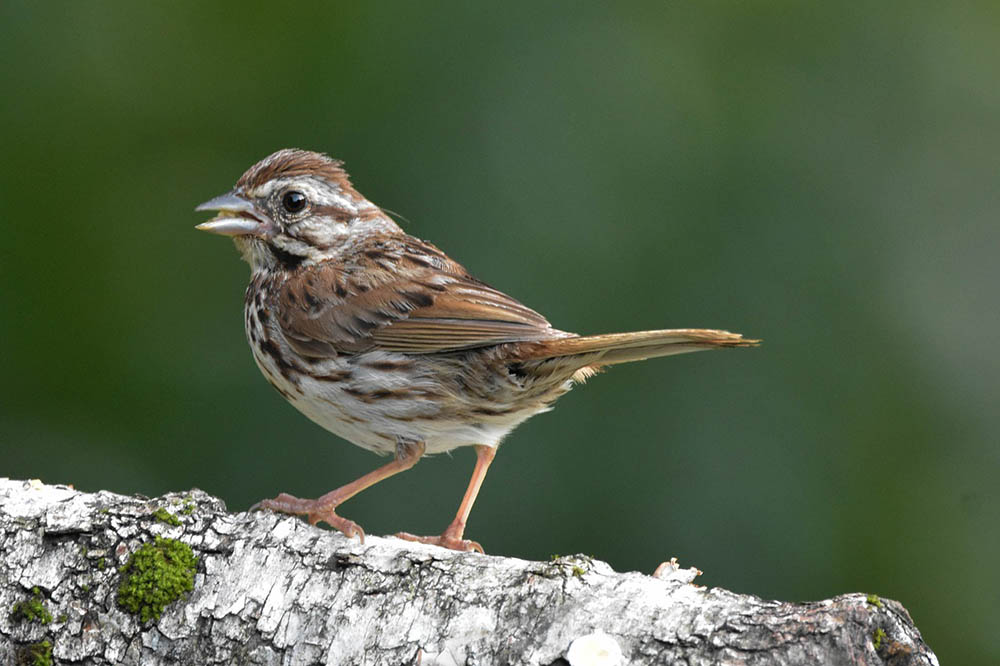
Sparrows are a common type of bird that can be found in South Dakota throughout the year but are especially abundant in the summer months. A total of 26 species can be spotted, with some, like the House Sparrow, being especially common and present all year round, despite it not being native to the region. Other species of sparrows are considered accidental visitors to the state but may very occasionally be spotted when they fly in from neighboring areas.
Below are 26 types of sparrows you can see in South Dakota, including information on their markings for easier identification and some information on what food can be used to attract them to feeders.

The 26 Types of Sparrows in South Dakota
1. American Tree Sparrow

| Latin name: | Spizelloides arborea |
| Size: | 5 inches |
| Weight: | 0.8 ounces |
| Season: | Winter |
The American Tree Sparrow migrates to South Dakota from Canada. They have long tails with gray faces and a copper-colored cap on top of their heads. The American Tree Sparrow gathers in small flocks to forage, is usually seen in fields, and can be attracted to feeders with sunflower seeds and nyjer.
2. Baird’s Sparrow

| Latin name: | Centronyx bairdii |
| Size: | 5 inches |
| Weight: | 0.7 ounces |
| Season: | Summer |
Baird’s Sparrows are relatively uncommon in South Dakota but may be spotted during the warm summer months. They can be found in pastures and grasslands as well as prairies. They have light brown bodies, mottled with dark brown, and have dark brown stripes on their heads.
3. Brewer’s Sparrow

| Latin name: | Spizella breweri |
| Size: | 5.5 inches |
| Weight: | 0.5 ounces |
| Season: | Summer |
The Brewer’s Sparrow is quite a dainty sparrow that is really only an occasional visitor to the region. They have gray bodies with brown streaking on their backs and heads. They are North America’s smallest sparrow and groups can sometimes be seen chasing larger predators away from nests.
4. Cassin’s Sparrow

| Latin name: | Peucaea cassinii |
| Size: | 6 inches |
| Weight: | 0.7 ounces |
| Season: | Summer |
Cassin’s Sparrows are another rare spot for South Dakota birdwatchers, but they can be seen in the summer months. They can be difficult to differentiate from other species because they have a plain brown and gray body with fine streaking. They typically live in deserts and grasslands and like tall grass.
5. Chipping Sparrow

| Latin name: | Spizella passerina |
| Size: | 5 inches |
| Weight: | 0.5 ounces |
| Season: | Summer |
Relatively common to South Dakota, the Chipping Sparrow can be spotted during the summer months and recognized by the rust-colored cap on their heads. The rest of the bird is gray and light brown. This species is usually found in woods but may also be found in some parks and may be attracted to feeders with cracked corn.
6. Clay-Colored Sparrow

| Latin name: | Spizella pallida |
| Size: | 5.5 inches |
| Weight: | 0.5 ounces |
| Season: | Summer |
With their gray bellies and brown-streaked wings, Clay-Colored Sparrows are quite plain looking, although they have white stripes on their head and neck that can help with identification. Although they can be seen in summer, this species is usually only spotted on its migratory path from Canada to Texas. Look in shrubland areas and listen for the two-tone song.
7. Dark-Eyed Junco
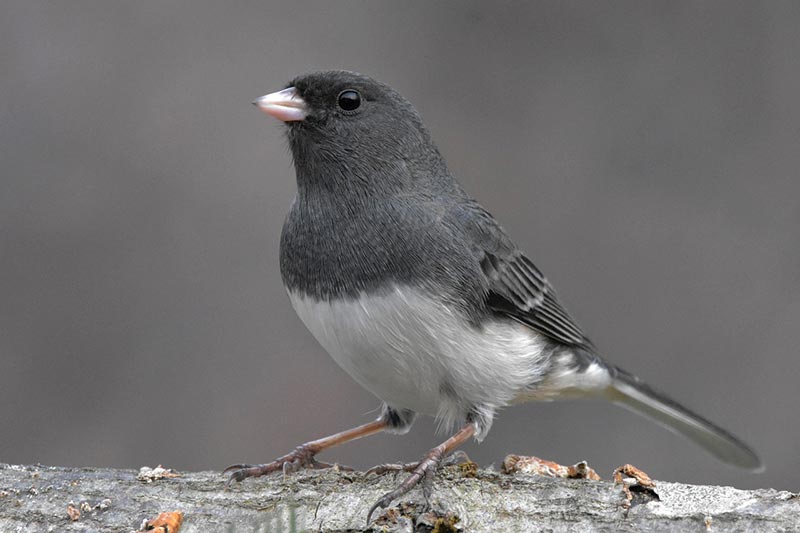
| Latin name: | Junco hyemalis |
| Size: | 6 inches |
| Weight: | 0.8 ounces |
| Season: | Winter |
Although more commonly seen during migration, Dark-Eyed Juncos are also a relatively common sight in winter. These birds are usually gray, and, as their name implies, they have very dark or black eyes. They prefer wooded habitats and are often called snowbirds because their winter arrival coincides with the first snow of the season.
8. Eastern Towhee
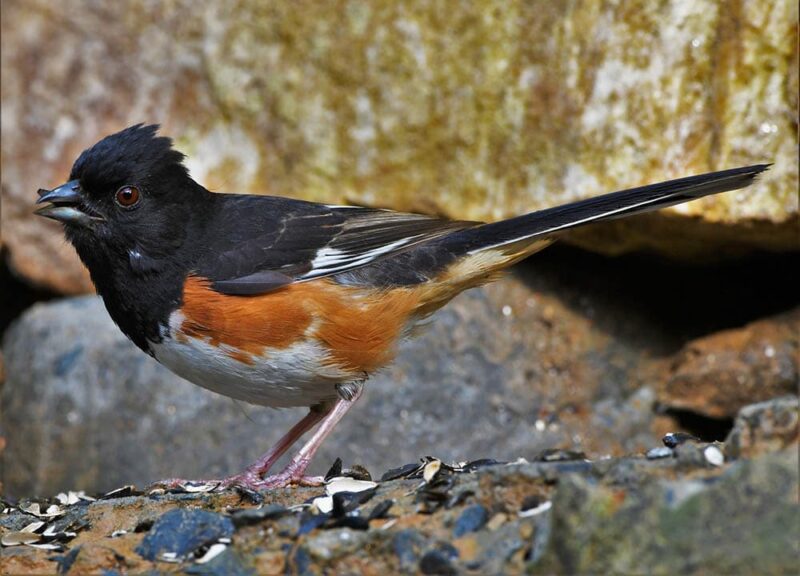
| Latin name: | Pipilo erythrophthalmus |
| Size: | 7.5 inches |
| Weight: | 1.5 ounces |
| Season: | Summer |
Although they are not common in South Dakota, Eastern Towhees are relatively easy to identify with a gray belly with a black back, wings, and head, with red on their sides. They are usually found at the edges of forests and can be attracted to feeders with a selection of black sunflower seeds, cracked corn, and millet.
9. Field Sparrow
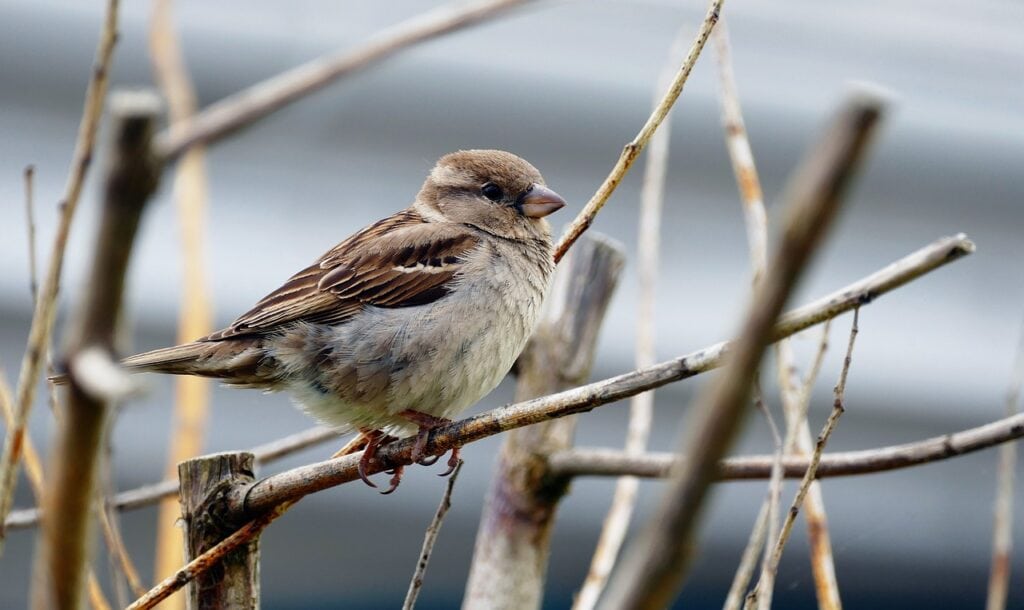
| Latin name: | Spizella pusilla |
| Size: | 5 inches |
| Weight: | 0.5 ounces |
| Season: | Summer |
South Dakota’s Field Sparrows are migratory, although those in the eastern states remain all year. This species likes to live in abandoned green areas and because they are quite timid birds, they can be difficult to locate. They do like cracked corn and millet if you are looking to attract them to your feeder.
10. Fox Sparrow
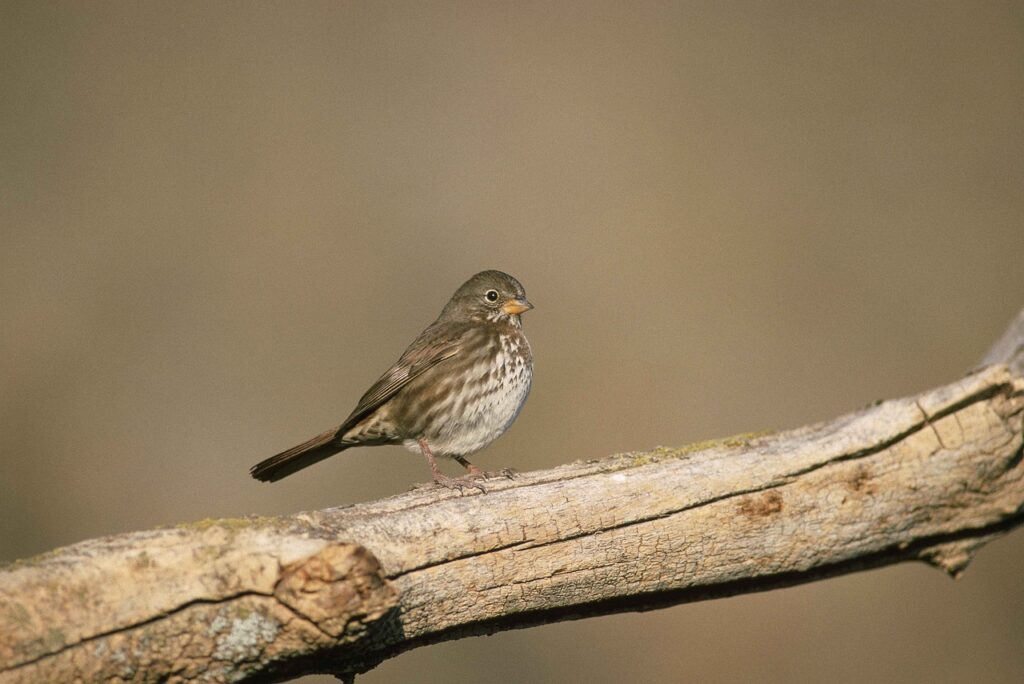
| Latin name: | Passerella iliaca |
| Size: | 7 inches |
| Weight: | 1.5 ounces |
| Season: | Migration |
Fox Sparrows are not really resident in South Dakota, but they do pass through during migration. Their red coloring, which is where they get the name Fox Sparrow, makes them quite distinctive, and they may be spotted in parks and around towns.
11. Grasshopper Sparrow

| Latin name: | Ammodramus savannarum |
| Size: | 4.5 inches |
| Weight: | 0.6 ounces |
| Season: | Summer |
These small sparrows have gray-brown bodies with brown streaks and an orange streak just above the eye. They are seen in South Dakota during the breeding season and are a fairly common sight in summer. As per their name, this species hunts and eats grasshoppers, although it will also dine on spiders. They also have a call that sounds somewhat like a grasshopper.
12. Harris’s Sparrow
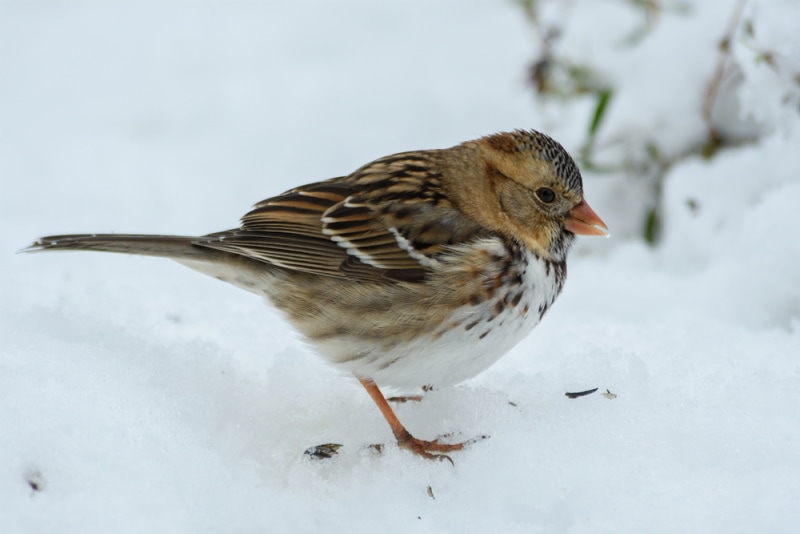
| Latin name: | Zonotrichia querula |
| Size: | 7 inches |
| Weight: | 1.4 ounces |
| Season: | Migration |
Primarily seen during spring and fall migration periods, some Harris’s Sparrows do remain in South Dakota during the winter months. The species is considered under threat. They are typically spotted in the open, feed on insects and seeds, and can be identified by their appearance. They have brown bodies, black faces and bibs, and gray or brown heads.
13. Henslow’s Sparrow

| Latin name: | Centronyx henslowi |
| Size: | 5 inches |
| Weight: | 0.5 ounces |
| Season: | Summer |
Although very rarely seen, Henslow’s Sparrows can be seen in the state during the summer months. The Henslow’s Sparro has a pale chest but a yellow-green face. They can be seen in wet grasslands, farms, and any other open green space.
14. House Sparrow
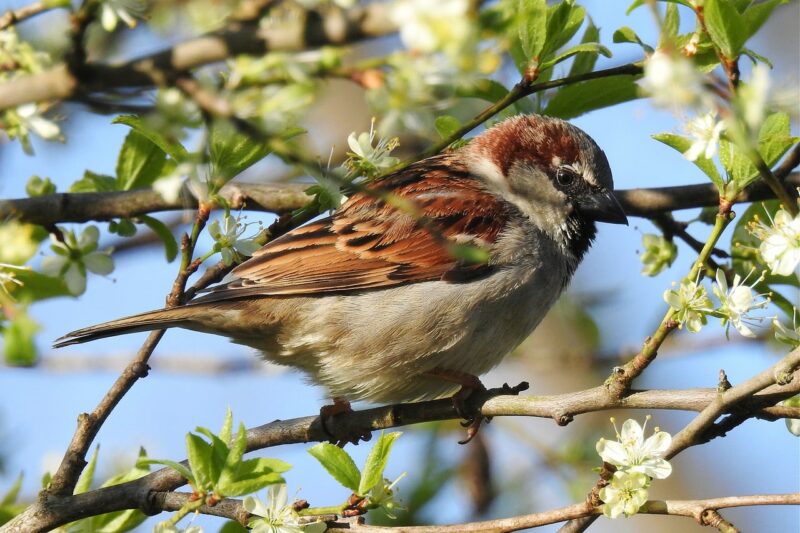
| Latin name: | Passer domesticus |
| Size: | 6 inches |
| Weight: | 1 ounce |
| Season: | All Year |
The House Sparrow is not native to South Dakota, but the introduced species is now a common sight and is found in the state throughout the year. Living around houses and being quite tame birds, House Sparrows have been known to eat directly from peoples’ hands. They will eat discarded leftovers and can be attracted to garden feeders with virtually any type of food.
15. Lark Bunting

| Latin name: | Calamospiza melanocorys |
| Size: | 6.5 inches |
| Weight: | 1.4 ounces |
| Season: | Summer |
The Lark Bunting is not a common bird in South Dakota, but it is easy to spot and identify from other sparrows. Males are black and have a white patch on their wings. They live in grasslands and eat seeds and insects.
16. Lark Sparrow

| Latin name: | Chondestes grammacus |
| Size: | 6.5 inches |
| Weight: | 1 ounce |
| Season: | Summer |
Common in most states, Lark Sparrows like open grasslands and they feed in summer and seeds in winter. They have a happy song and distinctive markings. The bird has a white belly. The brown tail has white edges, and the top of the head is brown and white striped. The Lark Sparrow will eat just about any type of seed at feeders.
17. LeConte’s Sparrow

| Latin name: | Ammospiza lectoneii |
| Size: | 5 inches |
| Weight: | 0.5 ounces |
| Season: | Migration |
LeConte’s Sparrows are only usually seen in South Dakota during their migratory flight and typically in October. They have light and dark brown bodies and wings with peach and brown heads. They eat seeds and insects and are most often seen in grassland areas.
18. Lincoln’s Sparrow

| Latin name: | Melospiza lincolnii |
| Size: | 5.5 inches |
| Weight: | 0.7 ounces |
| Season: | Migration |
The Lincoln’s Sparrow is another species that is only seen during migration but can be seen during spring and fall and is a relatively common sight during these times. Their bodies are gray but they have brown streaks on their wings and chests. They are usually spotted in dense thickets, although these shy birds are difficult to see.
19. Nelson’s Sparrow

| Latin name: | Ammospiza nelsoni |
| Size: | 5 inches |
| Weight: | 0.7 ounces |
| Season: | Migration |
Seen primarily in the fall migration period around October, Nelson’s Sparrows are gray and brown birds with an orange color around the head. They are found in wetlands or marshes and are most common in the east of the state.
20. Savannah Sparrow

| Latin name: | Passerculus sandwichensis |
| Size: | 5.5 inches |
| Weight: | 0.8 ounces |
| Season: | Summer |
As well as spending the breeding season in South Dakota, larger numbers of Savannah Sparrows also migrate through the state, so they are easier to see in March and October and are spotted in grasslands where they are hunting for spiders and other insects. To attract these birds, you will need long grass or a neighboring field.
21. Song Sparrow
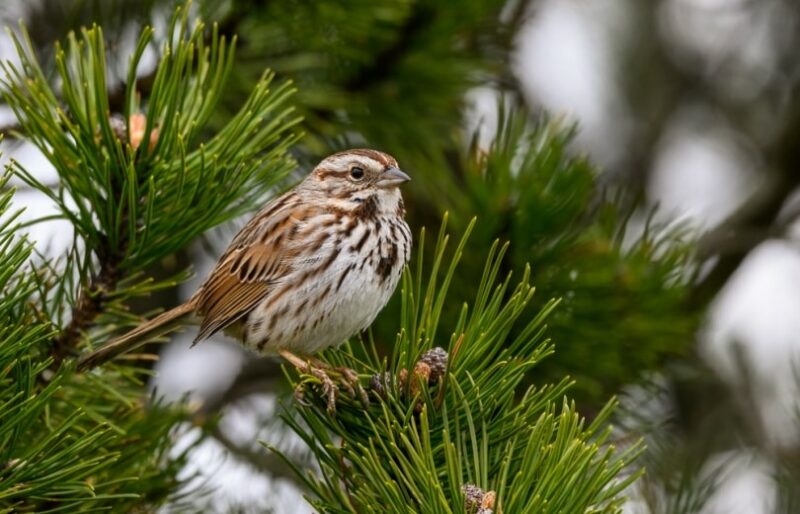
| Latin name: | Melospiza melodia |
| Size: | 6 inches |
| Weight: | 1.5 ounces |
| Season: | Summer |
Song Sparrows are considered somewhat plain to look at and are brown streaked across most of their bodies. However, they are prolific singers and are a very common sight during summer. They eat insects and will eat some seeds, and if you want to hear their incessant singing, you can attract them with black sunflower seeds.
22. Spotted Towhee

| Latin name: | Pipilo maculatus |
| Size: | 8 inches |
| Weight: | 1.5 ounces |
| Season: | Summer |
Towhees are also types of sparrows and the Spotted Towhee is a common sight in South Dakota’s summer. It is a large sparrow with a black back and head, white belly, red sides, and white spotting on its black wings. Ensure you have decent bushes for the bird to hide in and provide sunflower seeds and cracked corn to attract them to your feeders.
23. Swamp Sparrow
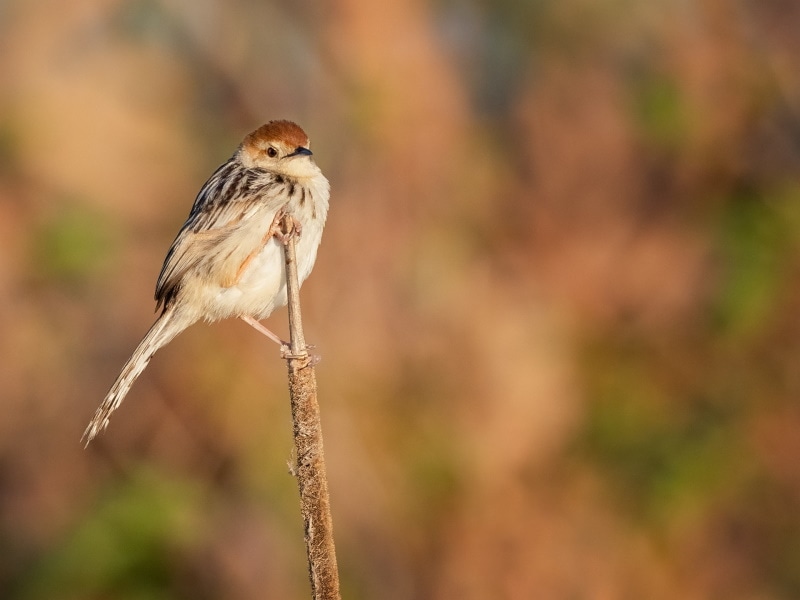
| Latin name: | Melospiza georgiana |
| Size: | 5 inches |
| Weight: | 0.7 ounces |
| Season: | Summer |
Some Swamp Sparrows can be seen in the state in summer, but numbers increase during October as migrating birds pass through South Dakota. They are dark brown with rust-colored wings and crowns. They prefer swamps and they can be heard singing before dawn.
24. Vesper Sparrow

| Latin name: | Pooecetes gramineus |
| Size: | 6 inches |
| Weight: | 0.8 ounces |
| Season: | Summer |
Vesper Sparrows are found in South Dakota during the summer months and are predominantly brown with white on their bellies and backs. They like grasslands and feed on insects and spiders as well as grasses.
25. White-Crowned Sparrow

| Latin name: | Zonotrichia leucophrys |
| Size: | 6 inches |
| Weight: | 1 ounce |
| Season: | Migration |
Although they are called White-Crowned Sparrows, this bird has a gray body, and it has a black and white striped crown. It is a large sparrow species and prefers grassy and overgrown areas. It is especially keen on sunflower seeds, which can be used to attract the White-Crowned Sparrow to some bird feeders.
26. White-Throated Sparrow

| Latin name: | Zonotrichia albicollis |
| Size: | 7 inches |
| Weight: | 1 ounce |
| Season: | Migration |
The White-Throated Sparrow is a large sparrow that is named for the fact it has a white throat but is more easily recognized by the black and white striped head and the yellow blushing on its face. The bird does not settle in the area but can be seen during spring and fall migration flights and may be convinced to stop at feeders if given millet and black sunflower seeds.

Final Thoughts
Sparrows are small songbirds that are located across North America and including South Dakota. Some are migratory birds that pass through the state, but others treat South Dakota as their home during the breeding season and others reside in the area all year round. Sparrows generally eat seeds, which can be used to attract them to feeders, although some species do also eat insects, grasses, and berries.
Featured Image Credit: JackBulmer, Pixabay
Table of Contents
- The 26 Types of Sparrows in South Dakota
- 1. American Tree Sparrow
- 2. Baird’s Sparrow
- 3. Brewer’s Sparrow
- 4. Cassin’s Sparrow
- 5. Chipping Sparrow
- 6. Clay-Colored Sparrow
- 7. Dark-Eyed Junco
- 8. Eastern Towhee
- 9. Field Sparrow
- 10. Fox Sparrow
- 11. Grasshopper Sparrow
- 12. Harris’s Sparrow
- 13. Henslow’s Sparrow
- 14. House Sparrow
- 15. Lark Bunting
- 16. Lark Sparrow
- 17. LeConte’s Sparrow
- 18. Lincoln’s Sparrow
- 19. Nelson’s Sparrow
- 20. Savannah Sparrow
- 21. Song Sparrow
- 22. Spotted Towhee
- 23. Swamp Sparrow
- 24. Vesper Sparrow
- 25. White-Crowned Sparrow
- 26. White-Throated Sparrow
- Final Thoughts
About the Author Robert Sparks
Robert’s obsession with all things optical started early in life, when his optician father would bring home prototypes for Robert to play with. Nowadays, Robert is dedicated to helping others find the right optics for their needs. His hobbies include astronomy, astrophysics, and model building. Originally from Newark, NJ, he resides in Santa Fe, New Mexico, where the nighttime skies are filled with glittering stars.
Related Articles:
Monocular vs Telescope: Differences Explained (With Pictures)
10 Types of Hummingbirds in Arkansas (With Pictures)
8 Types of Hummingbirds in Nebraska (With Pictures)
5 Types of Hummingbirds in Idaho (With Pictures)
3 Types of Hummingbirds in Mississippi (With Pictures)
8 Types of Hummingbirds in Kansas (With Pictures)
5 Types of Hummingbirds in West Virginia (With Pictures)
5 Types of Hummingbirds in Ohio (With Pictures)
